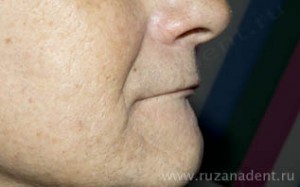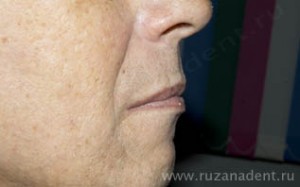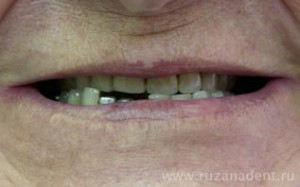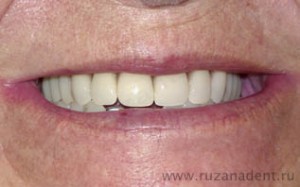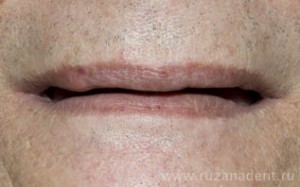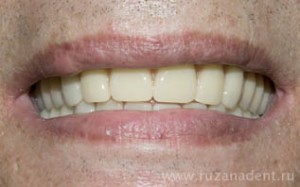Partially removable prosthetics
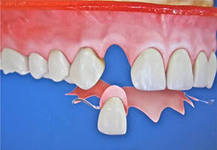
A partial removable prosthesis is a design that is used in cases where a part of the teeth is missing, but the jaw still has whole healthy teeth.
Such prostheses can restore lost teeth and correct cosmetic defects.
Partial removable prosthetics can be applied temporarily for some dental procedures.
Partial removable plate prosthesis
A partial removable laminar denture is one of the most affordable designs offered by modern orthopedics. But, as patients note, the laminar prosthesis is the most uncomfortable design, which often causes discomfort.
At the heart of the plate prosthesis is a plastic base, which is the basis for artificial teeth and fixtures. The plate prosthesis may be made of hard or soft plastic.
- Dentures made of hard plastic are very hard and not comfortable enough. Such a prosthesis is affordable for a wide range of patients.
- Lamellar constructions made of soft plastic are more convenient and comfortable, but their cost is several times higher.
Partial removable plate prostheses have both positive and negative sides.
Advantages of plate prostheses:
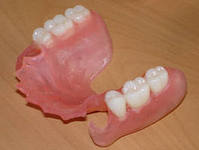
- rather cheap type of prosthetics;
- chewing load is distributed evenly on bone tissue;
- such prostheses are easy to care for;
- quick to manufacture and easy to install.
Disadvantages of removable plate prostheses:
- May cause discomfort and pain when used;
- Violation of taste perception;
- Change of diction.
Manufacturing steps
The manufacture of a removable partial denture requires frequent visits to the doctor. Partial dentures are made on average 2-4 weeks, the manufacturing steps of which can be represented as follows:
- clinical - performed by a doctor - orthodontist;
- laboratory - by a dental technician.
Stages of manufacturing a partial laminar prosthesis:
- Examination of the patient, diagnosis, design choice, taking casts.
- The wax mold is made according to the obtained impression.
- Fitting and determination of design parameters.
- The manufacture of the prosthesis.
- Fitting the prosthesis and transferring it to the patient.
- Correction of the prosthesis the next day, then - according to indications.
- The period of adaptation to a partial denture can last up to 2 months.
Types of partially - removable dentures
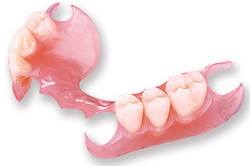
Depending on the indications, one or another removable design is possible.
Types of partial removable dentures:
- Lamellar. They are used in the absence of several teeth in a row.
- Immediate prostheses. Such designs are temporary.
- Clasp dentures. These are high-tech modern designs that replace several or a number of teeth.
- Nylon dentures. Used to restore one, two or more teeth.
Indications for installation
Partial dentures have the following indications:
- loss of primary chewing teeth;
- lack of teeth on the upper or lower jaws;
- fixed prosthetics with partial absence of teeth is impossible;
- installation of implants is contraindicated;
- as a temporary prosthesis;
- an allergic reaction to metal prostheses.
How to store
Care for removable dentures is the same as for teeth. They must be brushed with toothpaste at least twice a day.
- After each meal, the denture should be rinsed with clean running water.
- It is not recommended to eat viscous or sticky products, because they can cause structural damage.
- It is forbidden to chew chewing gum and eat solid food.
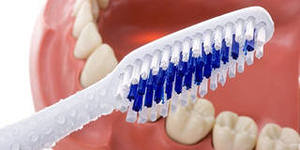
When using dentures, painful sensations may appear in the mouth.
This is due to the pressure of the structure on the mucous membrane of the oral cavity.
To eliminate the pain, correction of partial dentures is necessary.
- The first correction is carried out the day after their installation, and the prosthesis should be in the mouth for at least four hours.
- The following corrections in the amount of three or four times must be carried out within two weeks.
- The addiction to prostheses is long. In some cases, up to six months.
The adaptation to the design is affected by the fixation of partial removable dentures, the type of nervous system and other factors. Sooner or later, you can get used to prostheses.
Repairs
If the teeth began to wear out, the borders of the prosthesis have changed, cracks or any other damage appeared on the surface of the prosthesis, you should consult a doctor for repair.
It is mandatory to undergo a routine inspection once every six months.
Pros and Cons (disadvantages)
- The advantages of removable prostheses are that they are quite durable and safe.
- Designs are comfortable and aesthetic.
- Removable dentures can be placed at any age.
- The design flaws are that over time, such prostheses can cause bone atrophy. In this regard, dentists around the world have proposed replacing the lamellar basis of the prosthesis with a metal one.
- Flexite prostheses have virtually no contraindications and complications.
Contraindications (complications)
Removable dental structures are contraindicated in the following cases:
- An allergic reaction to the material from which the prosthesis is made.
- Diseases of the oral mucosa.
- Schizophrenia.
- Epilepsy.
- People of certain professions (singers, lecturers, broadcasters).
The basis of a removable denture can sometimes cause complications:
- Violation of temperature and taste sensitivity.
- Speech impairment.
- Irritation of the oral mucosa.
- Violation of self-cleaning of the oral cavity.
- Gag reflex to the presence of a prosthesis in the mouth.
- Teeth in contact with the clasp may wear out.
- Gum disease
How to attach (installation)
Methods of fixing removable structures in the oral cavity can be carried out using locks or clasps.
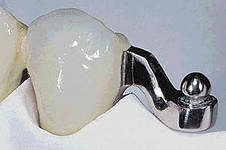
- Clasps are hooks attached to abutment teeth. They are attached at the very base of the teeth, so they are completely invisible when talking, smiling, etc. Clammers are made of metal or nylon. Thanks to the clamps, the prosthesis is firmly fixed in the mouth.
- Locks (attachments) consist of two parts: one of which is located inside the base of the prosthesis or artificial tooth, and the second on the abutment, under the artificial crown or in the root of the tooth. This method of fixing dentures is more aesthetic and reliable.
Life time
Modern removable dentures are quite durable and practical. The service life of acrylic dentures is an average of 4-5 years.
With increased atrophy of the bone tissue of the jaw, the service life of the structure is reduced to 2-3 years.
If the structure is properly looked after and adjusted in time, then dentures can be used for a longer time.
Frequently Asked Questions about Partially - Removable Dentures
- Question: How often to shoot them?
Answer: It is recommended to remove dentures twice a day in order to carry out their hygienic treatment.
- Question: Which are better - nylon or plastic?
Answer: Nylon dentures are hypoallergenic, aesthetic, comfortable, do not break, and plastic ones have more disadvantages.
- Question: How much do removable dentures cost?
Answer: The price of a removable denture depends on a number of factors: the material of which the structure is made, manufacturing complexity, number of teeth, type of attachment.
Below are the approximate prices of partially - removable dental structures
- A plate prosthesis costs from 5000 rubles.
- Removable dentures with partial absence of teeth - from 3000 rubles.
- A removable design for 1-2 teeth - from 5000 rubles.
- One-sided removable denture - from 11,000 rubles.
- A removable prosthesis with telescopic fixation - from 24,000 rubles.
More detailed answers to questions (indications, methods, materials) of partial removable prosthetics can be found in the book "Partial removable prostheses", authored by Nicholas J. A. Jepson.
Photo: before and after

